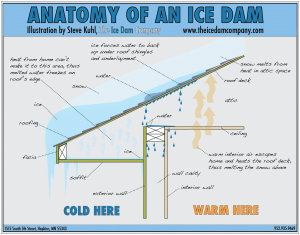Heated Gutters in South Charlotte, NC
Using Heat Tape To Create Heated Gutters
A heated gutter system consists of a gutter combined with self-regulating heat tape that is threaded through the gutters and downspouts beneath a gutter guard. This heat tape works by warming the gutter during winter, helping to prevent issues that can arise from the accumulation of snow and ice.
Talk to us about Heated Gutters Today!
Why Heated Gutters?
If you own a home in a colder climate, dealing with snow and ice on your roof can be a constant worry, especially regarding the risk of ice dams causing leaks.
The water damage that follows can quickly turn into a major headache for both you and your house. Harsh winters often bring unprecedented damage from ice damming, which can lead to expensive repairs. Large icicles that form along the roof’s edge above walkways and driveways also pose a safety hazard during the winter months. In some cases, the weight of accumulated snow and ice can become so great that it causes gutters to pull away from the house, crack, or even fall off entirely.
Many homeowners choose to install heat tape in their gutters to help prevent ice dams and gain some peace of mind. This special cable generates just enough warmth to melt snow and ice, reducing the risk of damage without harming your home.
What About Heated Tape on the Roof?
Unlike traditional roof heat cables that are placed on top of the roof and run along its edge, our approach involves installing heated gutter cables-also known as heat tape-inside the gutters, just beneath a gutter guard system, as well as inside the downspouts. This setup, which combines heated gutters with gutter guards, effectively addresses many issues commonly associated with standard roof heat tape or heat cable installations.
The real value of heat tape depends on proper installation. Many companies use various methods, with the most common being the zigzag pattern, which creates a series of triangles on the lower three feet of the roof. The cable is then positioned inside the gutter and downspout. While this method may help melt snow and ice on the roof, it does not prevent ice dams from forming in or on the gutters, as ice can still accumulate and restrict water flow.
Moreover, research has shown that installing heat tape directly on the roof can actually cause more long-term damage than not using any cable at all, and it may even void your roof’s warranty.
Heat Tape works better inside a Gutter System
We use Weather-Ready heat tape, installing it exclusively inside the gutters and downspouts to ensure that your shingles remain untouched and the heat tape stays protected while efficiently heating only the gutters. This approach is both highly effective and visually appealing. When paired with a gutter guard, the trapped heat from the tape keeps the entire gutter system warm. As snow on your roof melts, it encounters the warm gutter guard and gutter, which prevents ice and snow from accumulating in your gutter system. This means your gutters only have to manage water, not ice.
For the best results, turning on the heat cable just before snowfall begins is important. Heated cables are essential in regions with severe winters and heavy snowfall, as they help prevent ice dams and reduce the risk of water entering your home.
Snow Guards
Snow Guards, which should not be mistaken for gutter guards, serve a different purpose for roofs in regions with heavy snowfall. They are specifically designed to prevent snow or ice from sliding off the roof in large, dangerous sheets, helping to avoid sudden avalanches that could damage landscaping or pose a risk to people passing below.
Ice Dams
Ice dams typically form when a roof has uneven or insufficient insulation, or when other factors cause temperature fluctuations that let snow melt and flow down the roof. As this melted snow reaches the colder sections over the eaves, it refreezes, creating ice buildup along the roof’s edge or in the gutters.
This accumulation traps even more ice and water above it, which can back up beneath the shingles and seep into the attic, ceilings, and interior walls. Such water intrusion can result in costly repairs and may even require mold remediation if not addressed promptly.
What Causes Ice Damming?
There are a variety of reasons behind this problem. The most common reasons for ice damming are:

A lower roof pitch can lead to faster ice dam formation, and many homeowners notice ice damming near bathroom vents and chimneys due to temperature fluctuations in those areas. Traditional roof heat cables are typically installed on top of the roof, exposing the cable and sometimes causing ice to form above the heat tape.
This can shift the problem higher up the roof, away from the protection of the drip edge and ice/water shield. When the heat tape melts snow, the resulting water can refreeze as it moves toward the gutter, since gutters are often colder than the roof due to their exposure to cold air.
In contrast, a heated gutter system uses gutter heat tape to warm the entire gutter, preventing this refreezing and eliminating ice accumulation in the gutters. Without such a system, ice tends to build up in the gutters first, which leads many people to wonder if gutters cause ice dams.
Why Gutter Guards are an important part of a Heated Gutter System?
Gutter guards are intended to prevent leaves and debris from clogging your gutters, but they also offer additional benefits. They reinforce the gutter structure, help shield the heat cable, and keep snow out so it melts more quickly. When heat tape is installed inside the gutter, it warms the entire system, allowing snow to melt as it lands and reducing the risk of ice buildup, which can cause water to enter your home or create large icicles hanging from your roof or gutters. If the heat cable is left exposed to the elements, it can become damaged, and leaves and debris are more likely to get caught on it.
Are Heated Gutters Safe? What about potential fire hazards?
The Nuheat Weather-Ready heat tape installed by The Brothers that just do Gutters features a UV-resistant polyolefin outer jacket, a tinned copper braided layer, and a fire-resistant conductive core. Nuheat requires that each heating cable circuit be equipped with ground-fault protection to further reduce the risk of fire from continuous electrical arcing, which can occur if the cable is improperly installed or damaged. In some situations, a licensed electrician may be needed to complete the final connection. It is important to note that installing the heat cable directly on the roof’s surface can present a fire hazard. If you have any more questions about heated gutter systems or their installation, feel free to ask!
How much electricity does it use?
Your actual electrical usage will depend on the length of the cable run. The Nuheat Weather-Ready heat tape is designed to self-regulate its power output based on changes in the surrounding environment. When the ambient temperature drops and there is ice or snowfall, the heat tape increases its power output. As the temperature of the water and ice rises, the tape automatically uses less wattage and emits less heat. For further information, you can refer to our page on the cost of heated gutter systems.
Heated Gutter Demonstration
We put together a video demonstration of how a heated gutter system works. We placed piles of snow on top of the gutters so that viewers can see them melt through a time-lapse video.
For best results, your heat cable should be turned on prior to the snowstorm… so that the heated gutter will melt the snowflakes as they land. Once there is an accumulation of ice or snow, it will melt but takes more time and energy.
Note: For this simulation, we started with a mound of snow already on the gutter; during an actual snowstorm the flakes will melt as they land on the heated gutter. Be sure to visit our many blogs on this topic.
Installing Heat Tape – Using Heat Tape To Create A Heated Gutter
Several important factors need attention when installing heat tape. Spacing is crucial and should be determined based on the pitch of your roof and the length of the soffit. The heated cable is typically placed inside your gutters and downspouts, and the most effective approach involves installing it beneath a gutter guard. Using a gutter guard is highly recommended because it protects the cable and helps retain heat, allowing the entire system to work more efficiently and reducing the risk of ice dams.
To supply power to the heat tape, you can connect a premade length of heat tape or a GFCI plug-in cord set to an existing outdoor outlet, avoiding hardwiring. However, if you do not have an outdoor outlet or if your specific situation makes these solutions unworkable, it is advisable to consult an electrician to complete the power connection.
Table of Contents
Why Heated Gutters?
What about Heat Tape on the Roof?
Heat Tape works better inside a Gutter System
Snow Guards
Ice Dams
What Causes Ice Damming?
Why Gutter Guards are an important part of a Heated Gutter System?
Are Heated Gutters Safe? What about potential fire hazards?
How much electricity does it use?
Heated Gutter Demonstration
Installing Heat Tape
Talk to us about Heated Gutters Today!
Design the Perfect Gutter System
Complete the form today to book your free gutter estimate! Our solutionist will guide you through your options and craft a custom system for your house.



